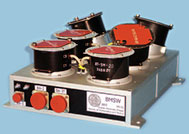Plasma-F: Three and a half month in orbit
Dr. G.N. Zastenker, leading researcher, IKI RAS
More than three months have passed since 'Plasma-F' payload aboard Russian astrophysical satellite SPECTR-R was switched on.
Among various phenomena, having occurred during this period (August 08 – November 05), of particular interest was extremely sharp disturbance of solar wind which reached the Earth on September 9, 2011 and was registered by BMSW plasma spectrometer.
First sign of the event appeared as a sharp increase of solar wind ion flux observed by BMSW detectors. Fig.1 shows one example of such observations made by three integral Faraday cups with different orientations towards Sun.
Four stages of the event are presented:
- little (approximately two times) and smooth (pending 20 minutes) increase of ion flux, as registered by all detectors (‘the foot’);
-
extremely sharp (in fractions of seconds) twofold increase of the flux (‘the front’);
-
smooth (pending around 35 minutes) flux increase approximately two fimes up to high values (‘the piston’);
-
sharp, but nonmonotonic decrease of the flux intensity over several minutes down to near initial values (‘the fall’).
Below are some details of the event.
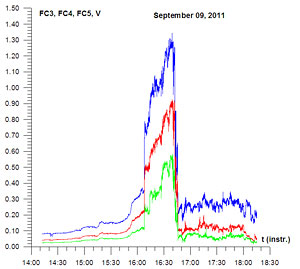 |
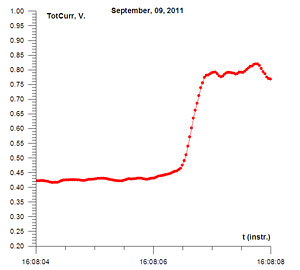 |
| Fig.1 | Fig.2 |
Surely, most impressive is extremely sharp increase of the flux, occurred at 16:08 (BMSW time frame). Using the BMSW’s unprecedentedly high time resolution (up to 30 ms for solar wind flux intensity and up to 1 s for other parameters), it was shown that flux velocity increase lasts no longer than 1 s, and approximately twofold flux intensity increase takes around 0.4 sec. The latter is shown on the Fig.2 with detailed course of flux intensity change (each dot corresponds to 30 ms). Such rapid variation of solar wind intensity was observed for the first time.
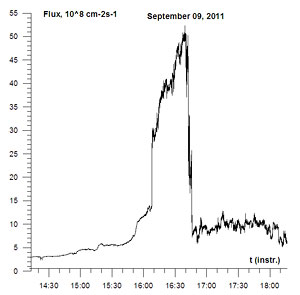 |
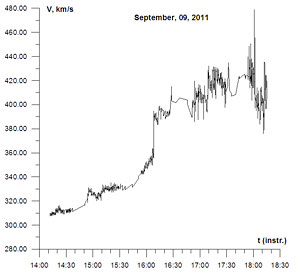 |
| Fig.3 | Fig.4 |
Another significant detail of the event is extremely high value of solar wind ion flux intensity and, therefore, its density. As shown on the Fig.3, ion flux reaches approximately 50*108 cm-2 s-1 in its maximum, which exceeds for more than an order of magnitude the long-standing mean value of the parameter.
However, contrary to what might be expected, the bulk velocity of solar wind flux and its changes are rather small. As Fig.4 shows, solar wind velocity is about 340 km/s before the flux increases, then it goes up from 350 to about 390 km/s as flux rapidly jumps, and then fluctuates around 400–420 km/s. Hence, the event observed happens in low-velocity solar wind.
Having determined bulk velocity, we may calculate the solar wind density using ion flux measurements. At the flux maximum we get the density value around 120 cm-3, which is an extremal value, approximately 20 times greater than the mean (that is, most frequently observed) values. Only once before in our measurements has the density reached this value, which occurred after the well-known event — the coming to Earth of magnetic cloud on Jan. 10, 1997.
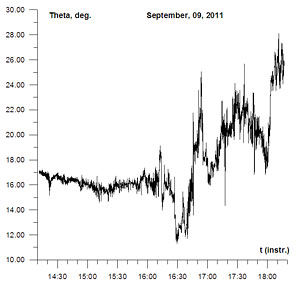 |
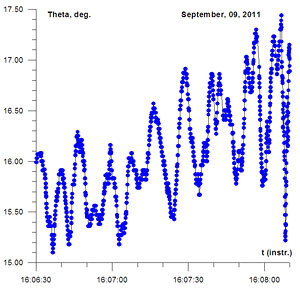 |
| Fig.5 | Fig.6 |
The important new feature of BMSW is that it allows to measure two angles of ion flux direction relatively to the instrument’s axis with high time resolution. Fig.5 shows time dependence of polar angle (i.e. an angle between flux direction and instrument’s axis) with time resolution of 30 ms in the event discussed.
It is shown, that it varies relatively little before rapid increase of the flux, and is around 16 degrees. Then its inclination to the instrument’s axis changes abruptly (comp. with the Fig.1), dropping down as low as to 12 degrees and increasing to 26 degrees in the end of the event.
Detailed analysis of angles’ variations with our instrument helps us to observe several curious phenomena, previously unregistered. For example, Fig.6 depicts quasi-harmonic oscillations of the polar angle in the range of 1–2 degrees with period around 10 s, observed before the sharp front of flux increase. These data resemble the forshock, frequently found in front of Earth’s bow shock , but with quasi-harmonic oscillations.
We can suggest two possible explanations for the nature of the event:
- that it is interplanetary shock (IPSh); however, it poorly agrees with the fact that solar wind velocity after the IPSh front is too close to the velocity of the shock itself, as derived from disturbances registered by two spacecraft;
-
that the fast flux runs over the slow one, thus generating strong compression of solar wind plasma in the front of speed jump (run-over).
Further studies will evidently help to clear this problem.

